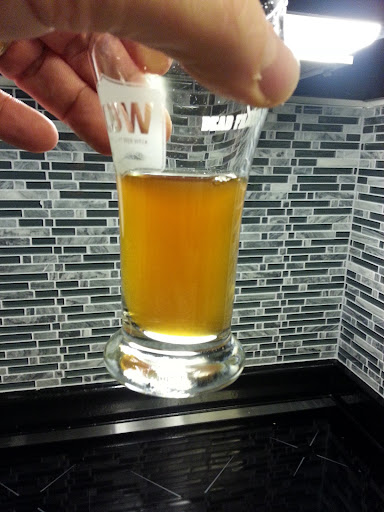Its been a long time since I had brewed and wow had I forgotten what a hot break is like, to have that foam reaching for the rim of the kettle with all that wort boiling hard below the surface. I got through it though with the help of a spray bottle and my finger hovering above the temp controls... what a rush! Here is the recipe that with the help of Unionrdr that I came up with for my can of Coopers select IPA, my wife is calling it IPAcalypse because of the brewing day.
1.7 kg can of thomas coopers ipa added at flame out
2 lbs of 2 row
1/2 lb of crystal 60 , both steeped at 160° for 1 hour
1 lb of amber lme
1/2 lb of light dme , both added at begining of boil
1 tsp of irish moss add at 10 minutes
Cascade hops .5 ounce at 40,20, and 5 minutes with anouther 1 ounce dry hopped in secondary
1/2 lb of coopers brew enhancer #2 added at 1 minute
Coopers yeast rehydrated with 1 tbsp of dme, pitched at 66°
All went well until I aerated the wort, pitched the yeast and then put the lid on the primary... the guy sold me a primary with no seal, I couldn't believe it, the friggin' lid was just banging back and forth on the bucket! I quickly grabbed my glass 6 gallon carboy, sanitized it and with the help of my endearing wife managed to pour the wort into the carboy through a small funnel. I hope the yeast will be OK.
I managed to record a starting gravity of 1046.
1.7 kg can of thomas coopers ipa added at flame out
2 lbs of 2 row
1/2 lb of crystal 60 , both steeped at 160° for 1 hour
1 lb of amber lme
1/2 lb of light dme , both added at begining of boil
1 tsp of irish moss add at 10 minutes
Cascade hops .5 ounce at 40,20, and 5 minutes with anouther 1 ounce dry hopped in secondary
1/2 lb of coopers brew enhancer #2 added at 1 minute
Coopers yeast rehydrated with 1 tbsp of dme, pitched at 66°
All went well until I aerated the wort, pitched the yeast and then put the lid on the primary... the guy sold me a primary with no seal, I couldn't believe it, the friggin' lid was just banging back and forth on the bucket! I quickly grabbed my glass 6 gallon carboy, sanitized it and with the help of my endearing wife managed to pour the wort into the carboy through a small funnel. I hope the yeast will be OK.
I managed to record a starting gravity of 1046.




